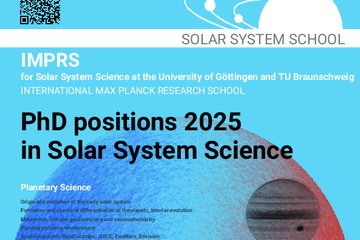All genres
161.
Conference Paper
Evolution of coronal hole boundaries seen in EIT 195 Å and TRACE 171 Å images. In: Modern Solar Facilities - Advanced Solar Science, pp. 249 - 252 (Eds. Kneer, F.; Puschmann, K. G.; Wittmann, A. D.). Universitätverlag Göttingen (2007)
162.
Conference Paper
Nonlinear force-free magnetic field modelling for VIM on SO. In: The Second Solar Orbiter Workshop (Eds. Marsch, E.; Tsinganos, K.; Marsden, R.; Conroy, L.). ESA Publ. Div., Noordwijk (2007)
163.
Conference Paper
Measuring the magnetic vector with the He I 10830 Å line: A rich new world. In: Solar Polarization 4, pp. 431 - 436 (Eds. Casini, R.; Lites, B. W.). (2006)
164.
Conference Paper
Non-Linear Force-Free Magnetic Fields. In: Proceedings of the International Scientific Conference on Chromospheric and Coronal Magnetic Fields (Eds. Innes, D. E.; Lagg, A.; Solanki, S. K.; Danesy, D.). ESA Publ. Div., Noordwijk (2005)
165.
Conference Paper
Magnetic loops: A comparison of extrapolations from the photosphere with chromospheric measurements. In: Proceedings of the International Scientific Conference on Chromospheric and Coronal Magnetic Fields (Eds. Innes, D. E.; Lagg, A.; Solanki, S. K.; Danesy, D.). ESA Publ. Div., Noordwijk (2005)
166.
Conference Paper
Why are coronal holes indistinguishable from the quiet sun in transition region radiation? In: Proc. SOHO 15 `Coronal Heating', pp. 35 - 40 (Eds. Walsh, R. W.; Ireland, J.; Danesy, D.; Fleck, B.). ESA Publ. Div., Noordwijk (2004)
167.
Conference Paper
SCHWARM - a swarm of small spacecraft to study plasma turbulence and magnetic field annihilation. In: Proc. 14th ESA Symposium on European Rocket and Balloon Programmes and Related Research, Potsdam, Germany, 31st May - 3rd June 1999, pp. 615 - 620 (Ed. Kaldeich-Schürmann, B.). ESA Publ. Div., Noordwijk (1999)
168.
Talk
Modelling solar and stellar coronal magnetic fields. Seminar: Ausgewählte Themen der Astrophysik, TU Berlin, Berlin, Germany (2019)
169.
Talk
Computing solar and stellar MHD equilibria. Seminar, AIP Potsdam, Potsdam, Germany (2019)
170.
Talk
Global coronal magnetic field modelling for Solar Orbiter. SPICE Operations Consortium Meeting , Göttingen, Germany (2019)
171.
Talk
Global coronal magnetic field modelling for Solar Orbiter. EGU General Assembly, Vienna, Austria (2019)
172.
Talk
Results of global NLFFF modeling for ISSI-meeting on Linking the Sun to the heliosphere using composition data and modelling. ISSI-meeting on „Linking the Sun to the heliosphere using composition data and modelling", Berne, Switzerland (2019)
173.
Talk
Global coronal magnetic field modelling: new models. ISSI-meeting on „Linking the Sun to the heliosphere using composition data and modelling", Berne, Switzerland (2019)
174.
Talk
Global non-potential coronal magnetic field models. Third working meeting on Use of Vector Synoptic Maps for Modeling, Göttingen, Germany (2018)
175.
Talk
Modelling solar, stellar and magnetospheric MHD equilibria. Purple Mountain Observatory, Nanjing, Nanjing, China (2018)
176.
Talk
Global magnetic field modelling for the Solar Orbiter mission. 6th Metis Workshop with Focus on Operations, Göttingen, Germany (2018)
177.
Talk
Global magnetic field modelling for the Solar Orbiter mission. Mini-Workshop on Solar Magnetic Field at the Purple Mountain Observatory, Nanjing, Nanjing, China (2018)
178.
Talk
Nonlinear force-free coronal magnetic stereoscopy. SOLARNET IV, The Physics of the Sun from the Interior to the Outer Atmosphere, Lanzarote, Spain (2017)
179.
Talk
Nonlinear force-free coronal magnetic stereoscopy. DPG Frühjahrstagung 2017, Bremen, Germany (2017)
180.
Talk
Nonlinear force-free coronal magnetic stereoscopy. DPG Frühjahrstagung 2017, Bremen, Germany (2017)











